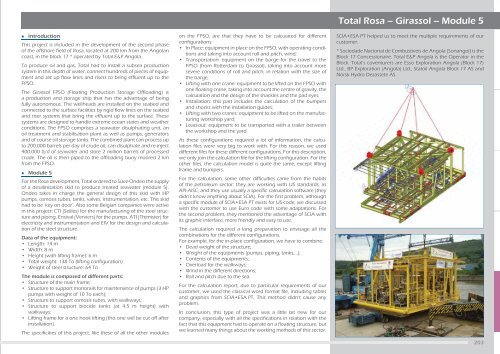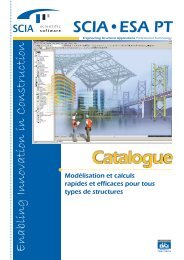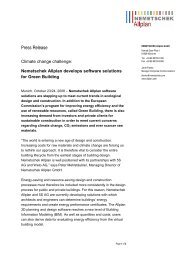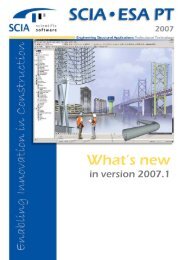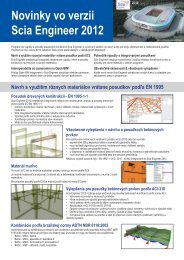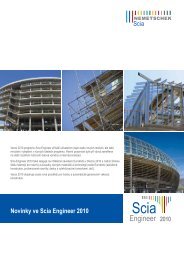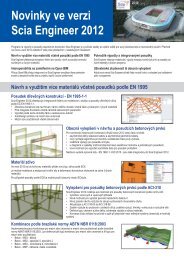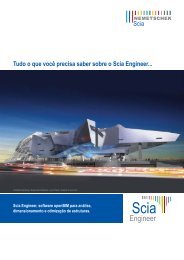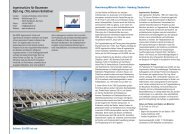VSH Turòa nad Bodvou - Nemetschek Scia
VSH Turòa nad Bodvou - Nemetschek Scia
VSH Turòa nad Bodvou - Nemetschek Scia
Create successful ePaper yourself
Turn your PDF publications into a flip-book with our unique Google optimized e-Paper software.
Introduction<br />
This project is included in the development of the second phase<br />
of the offshore field of Rosa, located at 200 km from the Angolan<br />
coast, in the block 17 * operated by Total E&P Angola.<br />
To produce oil and gas, Total had to install a subsea production<br />
system in this depth of water, connect hundreds of pieces of equipment<br />
and set up flow lines and risers to bring effluent up to the<br />
FPSO.<br />
The Girassol FPSO (Floating Production Storage Offloading) is<br />
a production and storage ship that has the advantage of being<br />
fully autonomous. The wellheads are installed on the seabed and<br />
connected to the surface facilities by rigid flow lines on the seabed<br />
and riser systems that bring the effluent up to the surface. These<br />
systems are designed to handle extreme ocean states and weather<br />
conditions. The FPSO comprises a seawater disulphating unit, an<br />
oil treatment and stabilisation plant as well as pumps, generators<br />
and of course oil storage tanks. The combined plant can process up<br />
to 200,000 barrels per day of crude oil, can disulphate and re-inject<br />
400,000 b/d of seawater and store 2 million barrels of processed<br />
crude. The oil is then piped to the offloading buoy moored 2 km<br />
from the FPSO.<br />
Module 5<br />
For the Rosa development, Total ordered to Suez-Ondeo the supply<br />
of a desalinisation skid to produce treated seawater (module 5).<br />
Ondeo takes in charge the general design of this skid with HP<br />
pumps, osmosis tubes, tanks, valves, instrumentation, etc. This skid<br />
had to be ‘key on door’. Also some Belgian companies were active<br />
in this project: CTI (Seilles) for the manufacturing of the steel structure<br />
and piping, Ensival (Verviers) for the pumps, ATI (Thimister) for<br />
electricity and instrumentation and EIV for the design and calculation<br />
of the steel structure.<br />
Data of the equipment:<br />
• Length: 14 m<br />
• Width: 8 m<br />
• Height (with lifting frame): 6 m<br />
• Total weight: 138 To (lifting configuration)<br />
• Weight of steel structure: 64 To<br />
The module is composed of different parts:<br />
• Structure of the main frame;<br />
• Structure to support monorails for maintenance of pumps (3 HP<br />
pumps with weight of 10 To each);<br />
• Structure to support osmosis tubes, with walkways;<br />
• Structure to support biocide tanks (at 4.5 m height) with<br />
walkways;<br />
• Lifting frame for a one hook lifting (this one will be cut off after<br />
installation).<br />
The specificities of this project, like these of all the other modules<br />
on the FPSO, are that they have to be calculated for different<br />
configurations:<br />
• In Place: equipment in place on the FPSO, with operating conditions<br />
and taking into account roll and pitch, wind;<br />
• Transportation: equipment on the barge for the travel to the<br />
FPSO (from Rotterdam to Girassol), taking into account more<br />
severe conditions of roll and pitch, in relation with the size of<br />
the barge;<br />
• Lifting with one crane: equipment to be lifted on the FPSO with<br />
one floating crane, taking into account the centre of gravity, the<br />
calculation and the design of the shackles and the pad eyes;<br />
• Installation: this part includes the calculation of the bumpers<br />
and shocks with the installation guides;<br />
• Lifting with two cranes: equipment to be lifted on the manufacturing<br />
workshop yard;<br />
• Load-out: equipment to be transported with a trailer between<br />
the workshop and the yard.<br />
As these configurations required a lot of information, the calculation<br />
files were very big to work with. For this reason, we used<br />
different files for these different configurations. For this description,<br />
we only join the calculation file for the lifting configuration. For the<br />
other files, the calculation model is quite the same, except lifting<br />
frame and bumpers.<br />
For the calculation, some other difficulties came from the habits<br />
of the petroleum sector: they are working with US standards, as<br />
API-AISC, and they use usually a specific calculation software (they<br />
didn’t know anything about SCIA). For the first problem, although<br />
a specific module of SCIA•ESA PT exists for US-code, we discussed<br />
with the customer to use Euro code with some adaptations. For<br />
the second problem, they mentioned the advantage of SCIA with<br />
its graphic interface, more friendly and easy to use.<br />
The calculation required a long preparation to envisage all the<br />
combinations for the different configurations.<br />
For example, for the in-place configuration, we have to combine:<br />
• Dead weight of the structure;<br />
• Weight of the equipments (pumps, piping, tanks,...);<br />
• Contents of the equipments;<br />
• Overload for the walkways;<br />
• Wind in the different directions;<br />
• Roll and pitch due to the sea.<br />
For the calculation report, due to particular requirements of our<br />
customer, we used the classical word format file, including tables<br />
and graphics from SCIA•ESA PT. This method didn’t cause any<br />
problem.<br />
In conclusion, this type of project was a little bit new for our<br />
company, especially with all the specifications in relation with the<br />
fact that this equipment had to operate on a floating structure, but<br />
we learned many things about the working methods of this sector.<br />
Total Rosa – Girassol – Module 5<br />
SCIA•ESA PT helped us to meet the multiple requirements of our<br />
customer.<br />
* Sociedade Nacional de Combustiveis de Angola (Sonangol) is the<br />
Block 17 Concessionaire. Total E&P Angola is the Operator in the<br />
Block. Total’s coventurers are Esso Exploration Angola (Block 17)<br />
Ltd., BP Exploration (Angola) Ltd., Statoil Angola Block 17 AS and<br />
Norsk Hydro Dezassete AS.<br />
203


